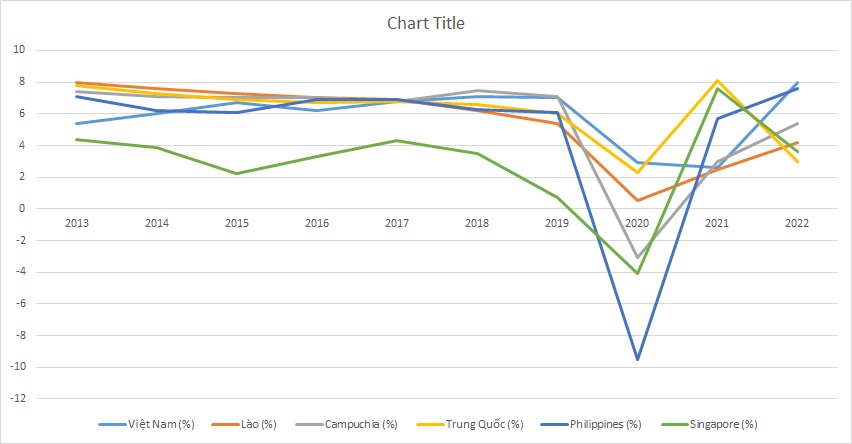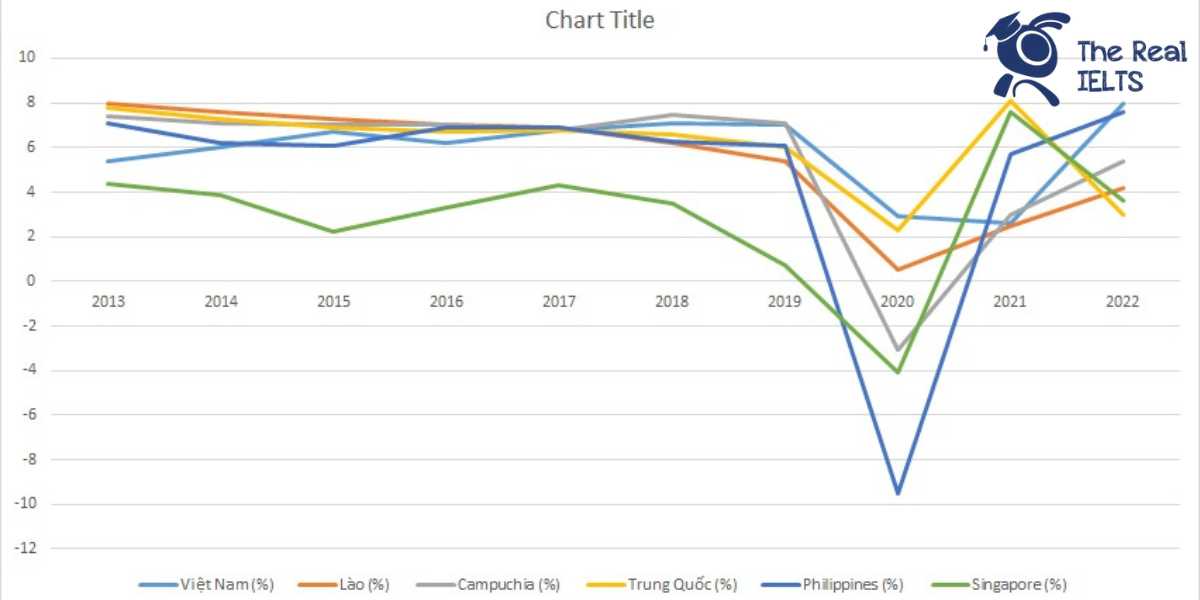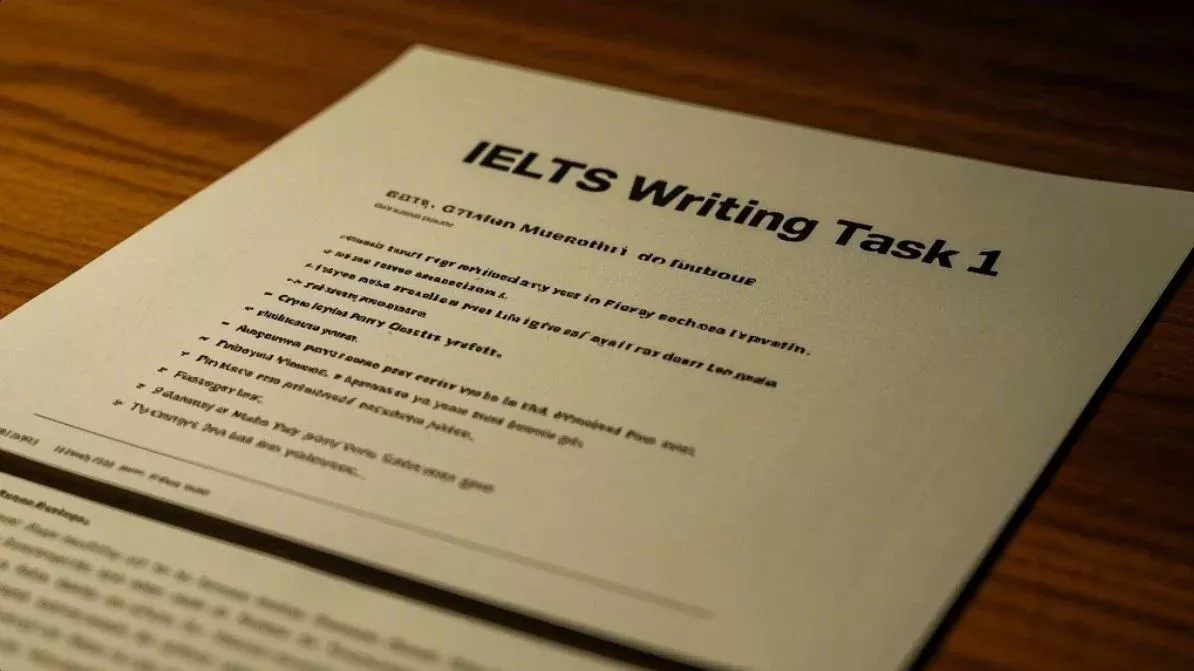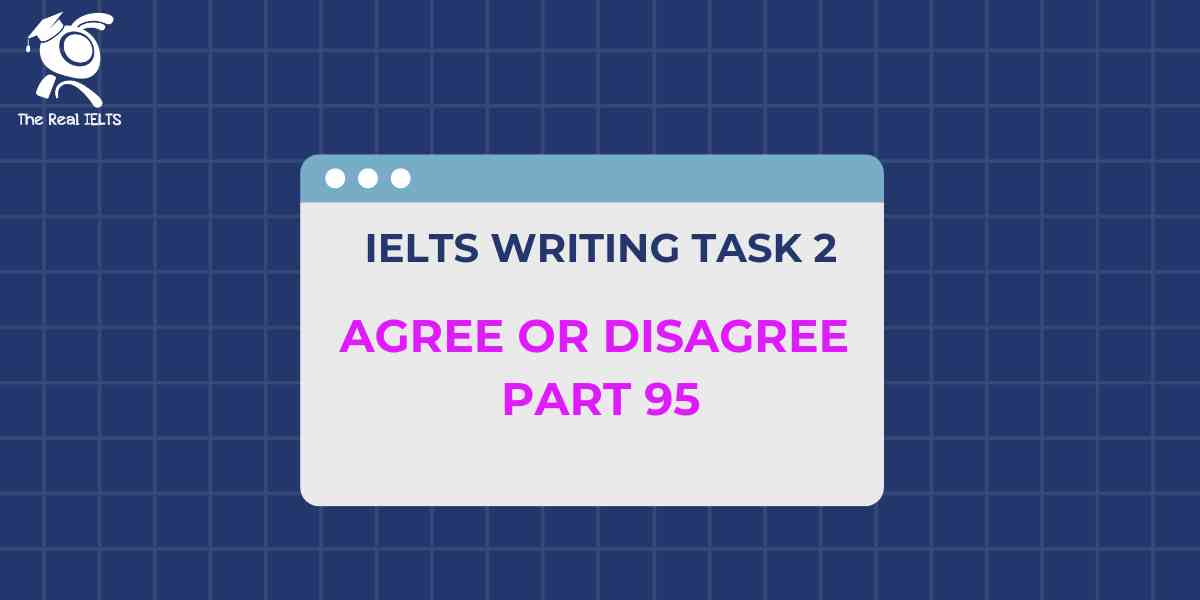Đồ thị đường trong bài IELTS Writing Task 1 Line Graph này thể hiện sự thay đổi GDP của các quốc gia từ năm 2013 đến 2022. Phân tích dữ liệu giúp làm rõ xu hướng phát triển kinh tế của các quốc gia này, từ đó đưa ra những nhận định và so sánh cụ thể về tốc độ tăng trưởng GDP.
Bạn có thể đọc lại bài nói về Task 1 tại đây: IELTS Writing Task 1 cần lưu ý những gì?
Bạn cũng có thể đọc thêm bài viết này vì đề bài này là IELTS Writing Task 1 biểu đồ Line Graph.
IELTS Writing Task 1 Line Graph: GPD
You should spend about 20 minutes on this task
The line graph in this IELTS Writing Task 1 illustrates the changes in GDP of various countries from 2013 to 2022. Analyzing the data clarifies the economic development trends of these countries, providing specific insights and comparisons regarding GDP growth rates.
You should write at least 150 words.


Bài Writing tham khảo 1
The line graph illustrates the annual GDP growth rates of six countries: Vietnam, Laos, Cambodia, China, the Philippines, and Singapore from 2013 to 2022.
Overview: Overall, the GDP growth rates for all six countries experienced fluctuations over the period. Vietnam and China generally maintained steady growth, while the Philippines and Singapore saw more dramatic changes, especially in 2020. Cambodia’s and Laos’ growth rates showed significant variability as well.
Body 1: From 2013 to 2019, Vietnam’s GDP growth rate increased steadily from 5.4% to 7.0%, with minor fluctuations. Similarly, Cambodia’s growth rate remained relatively stable around 7%, with minor ups and downs. Laos, on the other hand, showed a gradual decline from 8.0% in 2013 to 5.4% in 2019. China’s growth rate decreased gradually from 7.8% in 2013 to 6.0% in 2019, while the Philippines experienced a decline from 7.1% in 2013 to 6.1% in 2019. Singapore’s growth rate saw a more notable drop from 4.4% in 2013 to a mere 0.7% in 2019.
Body 2: In 2020, the impact of the COVID-19 pandemic is evident as all countries experienced significant drops in their GDP growth rates. Vietnam’s growth plummeted to 2.9%, and Laos and Cambodia saw their growth rates drop to 0.5% and -3.1%, respectively. The Philippines and Singapore faced severe contractions, with growth rates of -9.5% and -4.1%, respectively. China, however, managed a relatively modest decline to 2.3%. By 2022, Vietnam rebounded strongly to an 8.0% growth rate, and China recovered to 3.0%. Laos and Cambodia improved their growth rates to 4.2% and 5.4%, respectively. The Philippines and Singapore also bounced back to 7.6% and 3.6%, respectively, showing signs of economic recovery post-pandemic.
Bài Writing tham khảo 2
The line graph illustrates the annual GDP growth rates of six countries: Vietnam, Laos, Cambodia, China, the Philippines, and Singapore from 2013 to 2022.
Overview: Overall, the GDP growth rates for all six countries experienced fluctuations over the period. Vietnam and China generally maintained steady growth, while the Philippines and Singapore saw more dramatic changes, especially in 2020. Cambodia’s and Laos’ growth rates showed significant variability as well.
Body 1: From 2013 to 2019, Vietnam’s GDP growth rate increased steadily from 5.4% to 7.0%, with minor fluctuations. Similarly, Cambodia’s growth rate remained relatively stable around 7%, with minor ups and downs. Laos, on the other hand, showed a gradual decline from 8.0% in 2013 to 5.4% in 2019. China’s growth rate decreased gradually from 7.8% in 2013 to 6.0% in 2019, while the Philippines experienced a decline from 7.1% in 2013 to 6.1% in 2019. Singapore’s growth rate saw a more notable drop from 4.4% in 2013 to a mere 0.7% in 2019.
Body 2: In 2020, the impact of the COVID-19 pandemic is evident as all countries experienced significant drops in their GDP growth rates. Vietnam’s growth plummeted to 2.9%, and Laos and Cambodia saw their growth rates drop to 0.5% and -3.1%, respectively. The Philippines and Singapore faced severe contractions, with growth rates of -9.5% and -4.1%, respectively. China, however, managed a relatively modest decline to 2.3%. By 2022, Vietnam rebounded strongly to an 8.0% growth rate, and China recovered to 3.0%. Laos and Cambodia improved their growth rates to 4.2% and 5.4%, respectively. The Philippines and Singapore also bounced back to 7.6% and 3.6%, respectively, showing signs of economic recovery post-pandemic.















